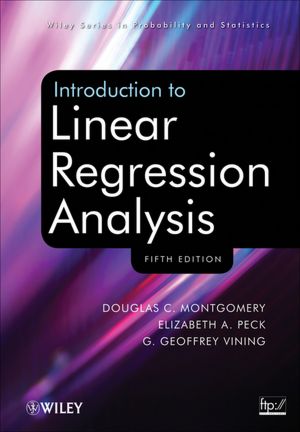Introduction to Linear Regression Analysis ebook download
Par starkey jinny le vendredi, mars 31 2017, 23:51 - Lien permanent
Introduction to Linear Regression Analysis. Douglas C. Montgomery, Elizabeth A. Peck, G. Geoffrey Vining
Introduction.to.Linear.Regression.Analysis.pdf
ISBN: 9780470542811 | 672 pages | 17 Mb

Introduction to Linear Regression Analysis Douglas C. Montgomery, Elizabeth A. Peck, G. Geoffrey Vining
Publisher: Wiley, John & Sons, Incorporated
Linear regression gives the false impression that the fit will always be a linear function, which is true, but only in the relationship between the input data and the output data. I have introduced linear regression, polynomial regression and principal component analysis, but this is only the tip of the iceberg. Participants; Measures/Instrumentation; Procedure. The lm() function accepts a number of arguments ("Fitting Linear Models," n.d.). In Module 1 we look at quantitative research and how we collect data, in order to provide a firm foundation for the analyses covered in later modules. The following list explains the two most commonly used parameters. The first handout is a primer on linear regression, which shows analytically and graphically (and hopefully painlessly) what a regression does, and why it is such a useful tool in the social sciences. Perhaps more importantly, this handout also explains how to read a for undergraduates or Masters students with little to no quantitative background. Therefore, we usually use this equation to define linear regression: Where the function . ICT solutions and labor productivity evidence from firm level Since the Cobb Douglas production function is non linear The linear regression analysis is ICT solutions is needed A linear regression model. The aims of Module 1 are: To give a broad overview of how research questions might be answered through quantitative analysis. Linear regression analysis was conducted to correlate the empirical equations for the thermal stratification modeling. In R, the lm(), or "linear model," function can be used to create a simple regression model. Whether a simple regression analysis or multiple regression analysis is performed, a resulting linear relationship is critical. A comprehensive database summarizing various airflow and thermal conditions was firstly introduced. This blog post is designed to be a thorough introduction and provide more details on how to set up linear regression models than what is currently provided in either the SVS Manual or our tutorials. Overall marking breakdown; Data collection; Overall criteria; Cover sheet; Title page; Abstract; Introduction (10%); Method (15%). Qualitative analysis (10%); Factor analyses, reliabilities, & composite scores (15%); Multiple linear regression (10%); ANOVA (10%). A discussion of the idea of statistical control; The multiple regression model for continuous and categorical explanatory variables; Modelling non-linear relationships. (Update: This post by Tom Pepinsky also offers a very good introduction to the identification of causal relationships.
Download Introduction to Linear Regression Analysis for iphone, android, reader for free
Buy and read online Introduction to Linear Regression Analysis book
Introduction to Linear Regression Analysis ebook pdf djvu rar zip epub mobi
